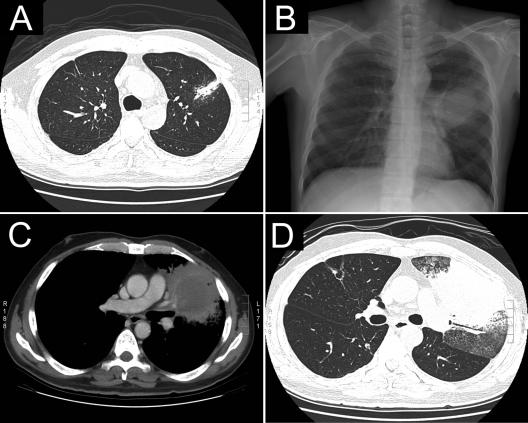Clostridial pleuropulmonary infections are rare; most of these infections are attributed to Clostridium perfringens (1), and none involving C. baratii have been reported. We describe here a fatal case of C. baratii lung abscess superimposed on invasive pulmonary aspergillosis.
A 47-year-old man was diagnosed with myelodysplastic syndrome with refractory anemia and excess blasts in December 2005. The disease course was complicated by disseminated Mycobacterium avium complex infection and invasive pulmonary aspergillosis. The patient underwent allogeneic hematopoietic stem cell transplantation in May 2006. One year later, he was admitted for leukemia relapse associated with febrile neutropenia. Chest radiography and computed tomography (CT) displayed multiple small opacities on the right upper and lower and left upper lung fields. Compared with chest CT results seen 1 year before, only the lesion on the left upper lung had increased in size (Fig. 1A). Low-grade fever persisted despite treatment with imipenem and voriconazole. Serum Aspergillus antigen results (Platelia Aspergillus enzyme immunoassay; Bio-Rad Laboratories) were negative. The lesion on the left lung progressed rapidly within 1 month (Fig. 1B). Follow-up chest CT results showed an abscess with a thick wall (Fig. 1C and D). In August 2007, the patient was admitted to an intensive care unit (ICU) because of acute respiratory failure. A sonography-guided transthoracic lung biopsy was performed on the second ICU day. Pathology examination of the lung biopsy sample disclosed narrow, dichotomous, and septated hyphae compatible with Aspergillus spp. Cultures of the lung biopsy sample and aspirates of the lung abscess as well as blood cultures all yielded C. baratii that was susceptible to penicillin, chloramphenicol, metronidazole, and cefmetazole but was resistant to clindamycin by a disk diffusion test. The patient's hemodynamics deteriorated, and the patient died of multiple organ failure on the twelfth ICU day.
FIG. 1.
(A) CT scan of the chest on admission, showing a small faint patch at the left upper lung field (LULF) and old fibrotic changes at the right upper lung field. (B to D) Follow-up chest radiography 1 month later disclosed a mass lesion at the LULF (B), and a CT scan at the same period (C and D) revealed a mass with a fluid-retaining central cavity, thick irregular wall, and a focal area of consolidation over the LULF.
The genus Clostridium has more than 150 species, but fewer than 20 are associated with human diseases (5, 7). Members of the genus are mainly natural inhabitants of the human intestinal tract, and their disease spectra in humans are broad (7). C. baratii has attracted limited attention because of its lack of overt pathogenesis and failure to produce lethal toxin. Its most striking clinical feature is its neurotoxogenesis, type F botulism in infants (4) and in adults (3, 4). However, C. baratii pulmonary infection in adults has never been previously reported in the literature. We speculate that the development of a lung abscess caused by C. baratii in this case may be closely related to the patient's leukemia relapse with persistent neutropenia and invasive pulmonary aspergillosis. The hyphae of Aspergillus species tend to invade blood vessels, which in turn leads to local thrombosis and tissue infarction (2, 6). Simultaneously, clostridial bacteremia originating from the disruption of the gastrointestinal mucosa results in seeding into the lung, with subsequent formation of lung abscess. The infection is refractory to antimicrobials in the face of tissue infarction despite the use of antimicrobial agents with in vitro activity against C. barati. In conclusion, among high-risk hosts, the rapid progression of fungal pneumonia into lung abscesses may suggest the presence of a superimposed infection due to an anaerobic bacterial species such as C. barati.
Footnotes
Published ahead of print on 3 January 2008.
REFERENCES
- 1.Bayer, A. S., S. C. Nelson, J. E. Galpin, A. W. Chow, and L. B. Guze. 1975. Necrotizing pneumonia and empyema due to Clostridium perfringens. Report of a case and review of the literature. Am. J. Med. 59851-856. [DOI] [PubMed] [Google Scholar]
- 2.Fraser, R. S. 1993. Pulmonary aspergillosis: pathologic and pathogenetic features. Pathol. Annu. 28(Pt. 1)231-277. [PubMed] [Google Scholar]
- 3.Gupta, A., C. J. Sumner, M. Castor, S. Maslanka, and J. Sobel. 2005. Adult botulism type F in the United States, 1981-2002. Neurology 651694-1700. [DOI] [PubMed] [Google Scholar]
- 4.Harvey, S. M., J. Sturgeon, and D. E. Dassey. 2002. Botulism due to Clostridium baratii type F toxin. J. Clin. Microbiol. 402260-2262. [DOI] [PMC free article] [PubMed] [Google Scholar]
- 5.Hatheway, C. L. 1990. Toxigenic clostridia. Clin. Microbiol. Rev. 366-98. [DOI] [PMC free article] [PubMed] [Google Scholar]
- 6.Kamai, Y., L. Y. Chiang, L. M. Lopes Bezerra, T. Doedt, A. S. Lossinsky, D. C. Sheppard, and S. G. Filler. 2006. Interactions of Aspergillus fumigatus with vascular endothelial cells. Med. Mycol. 44(Suppl. 1)S115-S117. [DOI] [PubMed] [Google Scholar]
- 7.Lorber, B. 2005. Gas gangrene and other clostridium-associated diseases, p. 2828-2838. In B. Mandell, J. E. Bennett, and R. Dolin (ed.), Principles and practice of infectious diseases, 6th ed. Churchill Livingstone, New York, NY.



